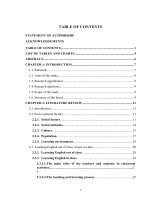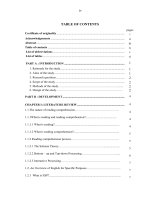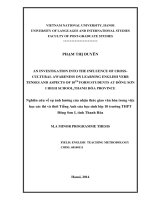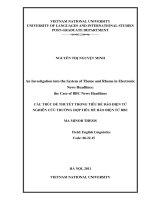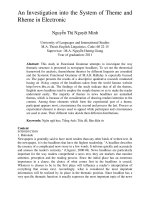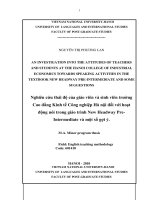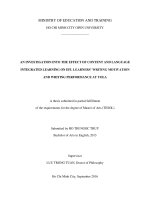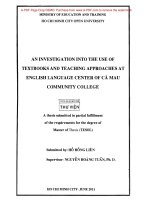An investigation into the difficulties of learning reading English for ESP of students of Finance and Banking on Hui Nghe An Campus = Tìm hiểu những khó khăn tr20150227.PDF
Bạn đang xem bản rút gọn của tài liệu. Xem và tải ngay bản đầy đủ của tài liệu tại đây (847.71 KB, 48 trang )
iv
Table of contents
pages
Certificate of originality i
i
Acknowledgements ii
ii
Abstract iii
iii
Table of contents iv
iv
List of abbreviations v
v
List of tables vi
vi
PART A : INTRODUCTION 1
1
1. Rationale for the study 1
1
2. Aims of the study 2
1
3. Research questions 2
2
4. Scope of the study 2
2
5. Methods of the study……………………………………………………
2
6. Design of the study…………………………………………………………
2
PART B : DEVELOPMENT 4
4
CHAPTER I: LITERATURE REVIEW 4
4
1.1.The nature of reading comprehension……………………………………
4
1.1.1What is reading and reading comprehension?
4
1.1.1.1 What is reading?
4
1.1.1.2 What is reading comprehension?
5
1.1.2 Reading comprehension process…………………………………………
5
1.1.2.1 The Schema Theory………………………………………
5
1.1.2.2 Bottom – up and Top-down Processing………………………………
6
1.1.2.3 Interactive Processing…………………………………………………
7
1.2. An Overview of English for Specific Purposes ……………………………
7
1.2.1 What is ESP?
7
v
1.2.2 English in Finance and Banking…………………………………….
8
1.3. Approaches to Teach E for Finance and Banking Reading………………
9
1.3.1 Grammar – Translation Approach………………………………………
9
1.3.2 Communicative Language Teaching Approach……………………
10
1.3.2.1 Content-Based Approach…………………………………
10
1.3.2.2 Task-Based Approach…………………………………………………
11
1.4.Techniques to Teach Finance and Banking Reading ……………………….
12
1.4.1 In Pre-Reading…………………………………………………………….
12
1.4.2 In While-Reading…………………………………………………………
12
1.4.3 In Post-Reading………………………………………………………….
13
1.5. Challenges in ESP Reading Comprehension ………………………………
13
1.5.1 Language problems…………………………………………………………
13
1.5.2 Reading skill problems
14
1.6. Summary
15
CHAPTER II: METHODOLOGY
16
2.1 The setting of study
16
2.1.1 The teachers ……………………………………………………………….
17
2.1.2 The students ……………………………………………………………….
17
2.1.3 The teaching materials ……………………………………………………
17
2.1.3.1 The course books…………………………………………………….
17
2.1.4 Teaching facilities…………………………………………………………
20
2.2. The study
20
2.2.1 Research questions
20
2.2.2 The participants
20
2.2.3 Research instruments 18
21
2.2.3.1 Questionnaire 19
21
vi
2.2.3.2 Informal interviews with ESP teacher……………………………….
21
2.2.4 Procedure of data collection………………………………………………
22
2.2.5 Procedure of data analysis
23
2.2.6 Summary 19
23
CHAPTER III : RESULTS AND DISCUSSIONS. 19
24
3.1 The students' questionnaires 20
24
3.2 The teachers' interview 25
30
3.3. Findings 28
32
3.4. Possible solutions 29
33
3.4.1 Raising the students’ awareness of the importance of reading in their
future job.
33
3.4.2. Improving teachers‘ specialized knowledge of Banking and Finance at
HUI Nghe An campus
34
3.4.3. Improving reading purpose of students
34
3.4.4. The teachers should be aware of the students’ needs
35
3.4.5. Im proving reading course books
35
PART C : CONCLUSION 40
36
1. Conclusions 40
36
2. Limitations and suggestions for further study
37
References
38
Appendixes
I
vii
List of abbreviations
HUI : Ho Chi Minh city University of Industry
ESP: English for Specific Purposes
EST: English for Science and Technology
EBE: English for Business and Economics
ESS: English for Social Sciences
EAP: English for Academic Purposes
EOP: English for Occupational Purpose
GE: General English
viii
LIST OF FIGURES, TABLES
Figure 1: Types of ESP by Hutchinson (1987: 16)
Table 1: Description of survey questionnaire
Table 2: Description of interview questions
Table 3: Students’ favorite in ESP reading
Table 4: Students’ perception about the purpose of learning reading English for Banking
Table 5: Students’ expectation about four language skills in their future work
Table 6: Levels of difficulties in terms of vocabulary
Table 7: The difficulties in the area of types of texts
Table 8: The difficulties in the area of reading skills
Table 9: The difficulties in the area of course books
Table 10: The learners’ expectation in terms of methodology
1
PART A: INTRODUCTION
1. Rationale for the Study
English is a compulsory subject at Ho Chi Minh city University of Industry ( HUI )
Nghe An campus. As a consequence ESP is also an importantly compulsory subject for
students who passed the GE courses. Having a good knowledge of GE and especially ESP
is considered to be necessary means for any graduates who wish to find a good job, better
in foreign companies or banks. Therefore, there is a growing and wide demand to learn
English at universities. As for the second year students at HUI Nghe An campus, ESP in
general , and English for Finance and Banking in particular is extremely important because
the students are expected to become people who work in the local banks and the
international banks. Thus, in the curriculum for Banking English there are parts for four
language skills. However, in this training base the teacher does realize that reading is given
the greatest account of the four skills in the course books. Moreover, in comparison with
writing, speaking and listening, it is reading that will be used most often in the students‟
future jobs.
To meet the demand of the learners, many ESP programmes have been
designed. Together with the worldwide trend to learn ESP, the teaching staff of Finance
and Banking Department at HUI collected documents and designed some ESP programmes
for Finance and Banking students at HUI. Therefore, to improve reading English skill in
Finance and Banking by working out some problems which may negatively have influence
on students‟ learning reading English for Finance and Banking and then suggest some
possible solutions to overcome those problems.
2. Aims of the Study
With the above rationale, my study was conducted with the following aims:
-To investigate the difficulties that HUI students meet when they learn reading
English for Finance and Banking.
-To recommend some suggestions for teachers and learners to overcome these
difficulties.
3. The research questions
2
The research is carried out with an attempt to find out the answers to the
following research questions:
1. What are the difficulties of students of Finance and Banking at HUI Nghe an
campus in learning to read ESP ?
2. What solutions can be offered to help students overcome the difficulties in learning
to read English of Finance and Banking ?
4. The scope of the study
This study is limited to the area of investigating in learning reading English for
Finance and Banking learning faced by the second-year students of Banking and Finance at
HUI Nghe An campus. More importantly, it tries to serve the purpose of finding out the
most common problems in the students‟ learning reading English for Finance and Banking
and seeking for possible solutions to deal with the found problems.
5. The method of the study
With the aims of finding out the area of difficulties in learning reading English for
Finance and Banking at HUI Nghe An campus, this study adopts a survey approach. To
achieve the aims of the study, the survey questionnaire is used as the main method to
collect the needed data from the learners as well as the researcher‟s observation and
interviews and informal discussion with the students and the colleagues.
6. Design of the study
The thesis was designed with three parts: Introduction, Development and
Conclusion. In the development part, it has three chapters.
The first part, the Introduction is an brief overview of the study with more details
of the rationale, the aims, the methods as well as the design of the study.
The second part, the Development includes three chapters:
Chapter one is a literature review. This chapter presents the theoretical background of
the thesis
Chapter two is methodology. It deals with the current situation of teaching and
learning English for ESP of Finance and Banking at HUI Nghe An campus. This chapter
3
also focus on background information of the subject of the study, the instruments used to
collect data and the procedure of data collection as well.
Chapter three will presents a description of data analysis and dicussions. With the
description of data analysis through two instruments: questionnaire and the semi-
interview, I explored some interpretations of the findings.
The last part, the Conclusion, is devoted to the summary of the findings and some
pedagogical suggested recommendations to help teachers and students HUI to overcome
difficulties in learning and teaching reading English for Finance and Banking. This part
also provides the limitations of the study as well as some recommendations for further
study.
Following these parts are the Appendixes and References of the study.
PART B: DEVELOPMENT
CHAPTER I: LITERATURE REVIEW
4
This chapter will briefly present a theoretical background of the study with the
examination of the concepts most relevant to the thesis‟s topic. Firstly, a general
introduction of nature of reading comprehension will be given. Secondly, the overall of
ESP will be discussed. Thirdly, approaches to teach reading and techniques to teach
English for Finance and Banking reading will be mentioned. Finally, challenges in ESP
reading comprehension will be referred to in reading classes.
1.1 The nature of reading comprehension
1.1.1. What is reading and reading comprehension?
1.1.1.1 What is reading?
Reading is an interactive process that goes on between the reader and the text,
resulting in comprehension. The text presents letters, words, sentences, and paragraphs that
encode meaning. The reader uses knowledge, skills, and strategies to determine what that
meaning is. So far reading has been defined differently by lots of scholars, however no
single definition is acceptable to everyone.
Goodman (1971, p.135) stated that reading is “a psycholinguistics process by
which the reader, language user, reconstructs, as best as he can, a message which has been
encoded by a writer as a graphic display”. In his opinion, readers not only learn how to
read the text, to master grammatical structures…but also understand the content expressed
in the text.
Having the same point with Goodman, William, E. (1990, p.2) said that “reading is a
process whereby one looks at and understands what has been written”. According William,
in reading process, there are also two parallel activities: looking and understanding.
Therefore, readers have to “encode” meanings of a word depend on the context in which it
appears.
One more definition offered by Harmer (1989, p.153) showed us his opinion and
two above authors have a lot of things in common “reading is an exercise dominated by the
eyes and the brain. The eyes receive messages and the brain then has to work out the
significance of these messages”.
Thus, obviously, definitions of reading have been various in using words and
expressions but they all focus on two activities: looking with eyes and understanding with
brains in which the latter is more important. The most noticeable thing in the latter is that
the interaction between readers and authors – readers not only read authors‟ words but also
read authors‟ thought.
5
1.1.1.2 What is reading comprehension?
Reading comprehension results in the fact that when readers know which skills and
strategies are appropriate for types of texts and understand how to apply them to
accomplish reading purpose. Swan (1975, p.1) stated that “A student is good at
comprehension we mean that he can read accurately and efficiently, so as to get the
maximum information of a text with the minimum of understanding”. It is obvious that the
student can show his understanding only by doing some tasks such as summarizing the
text, answering questions, making true or false etc.
To sum up, reading becomes meaningless without comprehension since only
reading comprehension can appreciate how much readers understand the text. Therefore,
how to help students have effective reading comprehension methods is considered to be the
most important part in reading teaching in general and ESP reading teaching in particular.
1.1.2 Reading comprehension process
The nature of reading comprehension process – how people learn to process textual
information – has been researched by cognitive and behavioral scientists for many decades.
So far reading has sometimes been characterized as “passive” or “receptive”. According to
Christine Nuttall (1982, p.192), “reading is like an infectious disease. It is caught not
taught (And you can‟t catch it from someone who hasn‟t got it…)”.
More recently, scholars (notably Goodman, 1967 and Smith, 1971) developed a
psycholinguistic perspective of reading, focusing on its active, cognitive processes.
1.1.2.1 The Schema Theory
According to Nunan (1999, p.201), “schema theory is based on the notion that
experiences lead to the creation of mental frameworks that help us make sense of new
experiences.”
The schemata are recognized as a useful concept in understanding how we are able
to interpret texts (Nuttall). When a reader reads a text, he must use his own background
knowledge, the situational context and the cues provided by the author to interpret the text.
How much he can understand a text depends on whether his schemata are sufficiently
similar to the writer‟s. That is why many arguments suggest that the concepts which a
reader brings to the text are actually more important than the text itself for comprehension.
Therefore, the more experiences of the world we have, the better we can interpret texts. A
reader who is rich in background knowledge will comprehend the text more than another
6
whose schemata are poorer. In addition, the schemata enable the reader to predict about
what he might get from a certain context.
To sum up, it is essential for teachers to recognize that the schemata are the basis
for comprehending. Therefore, in order to comprehend texts in standard English foreign
language students need to develop new schemata of language, text and interpretation, as
well as schemata of alternative cultural practices and values.
1.1.2.2 Bottom – up and Top-down processing
According to Silberstein (1994), “text comprehension requires the simultaneous
interaction of two models of information processing”.
The bottom – up processing occurs when readers get the meaning of a text through
recognizing letters and words, working out sentence structures and then interpreting
paragraphs and the whole text. According to this view, reading is a linear process by which
readers decode the text word by word, linking the words into phrases and then sentences.
When first reading makes readers confused or they are not really sure of what writers
intended, understanding of the meaning a sentence can have on its own will help readers
fully grasp what writers conveyed.
In the top – down processing, reading is not just extracting meaning from a text but a
process of connecting information in the text with the knowledge readers bring to the act of
reading. Reading, in this sense, is a dialogue between the reader and the text. It is seen as
an active cognitive process in which readers‟ background knowledge plays a key role in
the creation of meaning (Tierney and Pearson, 1994). This is called knowledge-based or
conceptually driven information processing.
In short, there are two ways that readers can use to deal with a text: using the
bottom – up processing to get detail understanding of the text and using the top-down to
understand main ideas about the text. Readers may use one of the two ways to comprehend
texts, however, readers usually need both of them to deal with difficult texts. As a result,
this leads to interactive processing.
1.1.2.3 Interactive processing
It is known that no single method is the best. A successful reader should combine
top-down and bottom-up processing, which is called interactive reading:
7
“In practice, a reader continually shifts from one focus to another, now
adopting a top-down approach to predict probable meaning, then moving
to the bottom-up approach to check whether that is really what the writer
says”. Nuttall (1996, p.17)
According to Hayes (1991, p.7),
“in interactive models, different processes are thought to be responsible
for providing information that is shared with other processes. The
information obtained from each type of processing is combined to
determine the most appropriate interpretation of the printed pages”.
In short, the popularity of interactive processing shows that interactive processing
can maximize the strengths and minimizes the weaknesses of the bottom-up and top-down
processing.
1.2. An Overview of ESP
1.2.1 What is ESP ?
ESP originates from a famous saying “Tell me what you need English for and I
will tell you the English that you need”. So far, ESP has been defined differently by
different authors. According to Hutchinson and Waters (1987, p.19), ESP is “an approach
to language teaching in which all decisions as to content and approach are based on the
learner‟s reason for learning”.
Sharing with Hutchinson and Waters, Strevens (1988, p.1) said “ESP is a particular
case of the general category of special – purpose language teaching”.
However, all the above authors have the same opinions about the ESP‟s features:
1) It is purposeful and aimed at the successful performance of occupational or educational
roles by an individual or a group.
2) It is based on an analysis of the students‟ needs and is tailor-made to meet these needs.
3) It may differ from another general language course in its selection of skills, themes,
topics, situations, functions, language and approachology.
Most of all, according to Munby (1978), one important feature which characterizes ESP as
being different from other general language courses, is that “the domains not only relate to
distinctive content, but also to discipline-specific lexis, genres and registers.”
1.2.2 English in Finance and Banking
8
According to the tree of ELT given, ESP can be classified into two major groups:
English for Academic Purposes (EAP) and English for Occupational Purposes (EOP).
English for Economics belongs to EAP and English in Finance and Banking is one of
branches of English for Business and Economics.
ESP
EST EBE ESS
EAP EOP EAP EOP EAP EOP
English for English for English for English for English for English for
Medical Study Technicians Economics Secretaries Psychology Teaching
Figure 1: Types of ESP (Hutchinson, 1987: 16)
Therefore, English for Finance and Banking has the following characteristics:
1) designed to meet specified needs of the learner in the field of Finance and
Banking;
2) related in content (that is in its themes and topics) to Finance and Banking
disciplines, occupations and activities;
3) centered on language appropriate to Finance and Banking activities in syntax,
lexis discourse, semantics and so on, and analysis of the discourse;
1.2.3. Purposes of teaching and learning reading English for Finance and Banking at
HUI Nghe An campus:
It is a certain that every training institution must have its own purpose in training
and that guides different purposes in English teaching. To Robinson, P.C.( 1997:7), needs
firstly can refer to students „s study or job requirements that is what they have to be able to
do at the end of their language course. Needs in this sense are perhaps more appropriately
9
described as “ objectives”. Needs can also mean “ that the user- institution or society at
large regards as necessary or to be learnt from a program of language instruction”.
At HUI Nghe An campus, students learn English not with the intention of taking it
professionally in the future career, but using it as a means to complete their certain banking
activities like: opening accounts, filling in slips, doing banking transaction between banks
and or with customers or even for their future training. And it is HUI „target to equip
students with necessary English which is frequently used in their business. That is, English
is taught generally to meet the students‟ future job requirement
1.3 Approaches to teach reading
In fact, there are quite a lot of approaches of teaching GE reading in general and
ESP reading in particular. However, in this study, I would like to mention about two
approaches which are most commonly used in teaching ESP reading: Grammar –
Translation approach and Communicative Language Teaching approach.
1.3.1 Grammar – Translation Approach
The Grammar Translation Approach is the oldest approach of teaching in the
world. A number of approaches and techniques have been evolved for the teaching of
English and also other foreign languages in the recent past years, yet this approach is still
in use in teaching. The main principles on which the Grammar Translation Approach are
based are the following:
1. Translation interprets the words and phrases of the foreign languages in the best
possible manner.
2. The phraseology and the idiom of the target language can best be assimilated in the
process of interpretation.
3. The structures of the foreign languages are best learned when compared and
contrast with those of mother tongue.
Advantages:
1. The phraseology of the target language is quickly explained. Translation is the
easiest way of explaining meanings or words and phrases from one language into
another.
2. Teachers‟ labor is saved when they use their mother tongue in teaching and learners
will not have much difficulty in responding to questions on the mother tongue.
10
Disadvantages:
1. Exact translation is not possible. Translation a language with various customs,
traditions and modes of behavior is, indeed, a difficult task and exact translation
from one language to another is not always possible.
2. Translation does not give pattern practice. It rather attempts to teach language
through rules and not by use. Researchers in linguistics have proved that to speak
any language, whether native or foreign, entirely by rule is quite impossible.
1.3.2 Communicative Language Teaching Approach
Communicative Language Teaching (CLT) dated from the late 1960s is perhaps the
latest in a long succession of revolutions in language teaching since it presents a
fundamental paradigm shift– a radically new approach to teaching-learning process. In
terms of ESP reading teaching, CLT is most used with two approaches: Content-Based
approach and Task-Based approach
1.3.2.1 Content-Based approach
Brown, H.D. (2001, p.234) stated that “content-based language teaching integrates
the learning of some specific subject-matter content with the learning of a second
language”.
He also claimed that the overall structure of a content-based curriculum “is dictated by
nature of the subject matter than by language forms and sequences. Hereafter are some
advantages and disadvantage of this approach:
Advantages:
1. The strength of the content-based approach is that language learning is
contextualized and purposeful.
2. The content-based approach motivates learners‟ activeness. Learners are forced
to think and activate their knowledge to guess the terms as well as the whole content of one
text.
Disadvantage:
11
The content-based approach is difficult to apply especially for learners who are low
in English competence. Furthermore, learners who use this approach to read ESP materials
have certain knowledge about that specific field.
1.3.2.2 Task-Based approach
According to Brown, H.D. (2001, p.50), Task-Based approach “puts task at the
center of one‟s methodological focus. It views the learning process as a set of
communicative tasks that are directly linked to the curricular goals they serve…”
In reading comprehension, tasks are especially important since they will guide reader
in a correct reading procedure and help them have thorough understanding about reading
texts.
Advantages
1. Task-based learning is more student-centered, allows for more meaningful
communication, and often provides for practical extra-linguistic skill building.
2. Tasks are likely to be familiar to students who are more likely to be engaged, which
may further motivate them in their language learning.
Disadvantages:
There have been criticisms that task-based learning is not appropriate as the
foundation of a class for beginning students. Others claim that students are only exposed to
certain forms of language, and are being neglected of others, such as discussion or debate.
1.4. Techniques to teach English for Finance and Banking reading
1.4.1 In Pre-reading
At this important stage, teachers should make sure that students have the relevant
schema for understanding the text. This is achieved by having students think, write, and
discuss everything they know about the topic employing the most common techniques such
as prediction, semantic mapping and reconciled reading.
12
Prediction is defined as “the prior elimination of unlikely alternatives”. Smith (1994, p.
19). According to him, predictions are questions readers ask the world and comprehension
is receiving the answers.
Previewing occurs when students look at titles, headings, and pictures, and read the first
few paragraphs and the last paragraph; these activities can then help students understand
what texts is about by activating their formal and content schemata and making them
familiar with the topic before they begin reading.
Semantic mapping is another pre-reading that Carell, Pharis, and Liberto (1989, p.651)
describe as a useful way to pre-teach vocabulary and to “provide the teacher with an
assessment of the students‟ prior knowledge or schema availability on the topic”. This
activity asks students to brainstorm about the reading topic as the information is displayed
on a graphic “map”.
Reconciled reading lesson reserves the sequence presented by many textbooks where the
text is followed by questions. Instead, the teacher develops pre-reading questions from the
questions that appear at the end of the reading.
1.4.2 In While-reading
This stage requires teachers to guide and monitor the interaction between readers and
texts. One important skill teachers can impart at this stage is note-taking, which allows
students to compile new vocabulary and important information and details, and to
summarize information and record their reactions and opinion.
Furthermore, during reading, readers‟ minds repeatedly engage in a variety of
processes, seemingly all at one. Using top-down and bottom-up approaches, readers use
pre-reading information to make some predictions about the text. Using bottom-up
approach, readers start by processing information at the sentence level.
1.4.3 In Post-reading
This stage offers the chance to evaluate students‟ adequacy of interpretation, while
bearing in mind that accuracy is relative and that “readership” must be respected as long as
the writer‟s intentions are addressed (Tierney and Pearson, 1994).
Post-reading aims at extending the understanding obtained from texts the pre-reading and
while-reading stages into writing tasks, such as summarizing, evaluating, synthesizing,
commenting and reflecting.
13
By engaging students in pre-, while-, post-reading activities, teachers not only support
students‟ understanding of content, but also provide them with opportunities to hone their
comprehension, vocabulary, and study skills without interrupting content learning.
1.5. Challenges in ESP reading comprehension
1.5.1 Language problems
Language plays a vital role in reading in general and ESP in particular. One cannot
read a book in a language unless one knows that particular language. If learner‟s
knowledge of English is poor, then his reading will be also poor, and naturally also his
reading comprehension. The guessing or the predicting ability necessary to pick up the
correct cues is hindered by the imperfect knowledge of the language; the wrong choice of
cues or the uncertainty of choice makes association more difficult; the memory span in a
foreign language in the early stages of its acquisition is usually shorter than in our native
language; recollection of previous cues then is more difficult in a foreign language than in
a mother tongue; and at all levels, asnd at all time, there is interference of the native
language.”
From the above viewpoints, problems of foreign language learners in reading process
are mainly caused by the imperfect knowledge of the target language and the interference
of the native language.
It is agreed that a lack of appropriate linguistics constrains the transfer of reading skills and
strategies from L1 to L2.
When dealing with a reading text, readers not only face with unfamiliar topic but also
difficulties in vocabulary and grammatical structures. They deal with idioms, proverbs,
synonyms, antonyms, etc., which can be considered to have an impact on the readers‟
motivation. Knowing vocabulary and structures is necessary for getting meaning from a
text, especially for second or foreign language readers who frequently say that they need
more vocabulary and structures so that they can understand the meaning of the sentences.
Therefore, when the amount of vocabulary and structures is limited, the readers will
encounter difficulties. As a result, they will be unwilling to explore the text.
1.5.2 Reading skill problems
Students‟ limited reading skills create many problems such as reading slowly, failing to
understand and summarize main ideas of the reading text, unable to guess or predict
meaning of the words or phrases used in that context, etc. Very frequently, student reading
14
in a foreign language seems to read considerably slower than they reportedly read in their
first language. Some students who read too slowly will easily get discouraged. They do not
know how to use the appropriate ways to move their eyes from word groups to word
groups. They just look at every single word, and consequently fail to grasp the general
meaning of the passage. Sometimes readers may encounter a text, which is too long.
Reader may know a lot of vocabularies, and the topic of the text is fairly familiar to them,
yet they cannot concentrate well on the text and when they get to the last paragraph, they
cannot recall what they have read before.
Reading is an active skill, involving guessing, predicting. It is common that there are
new words, new structures, and ideas in a reading text to every language learners. If he
does not have a good guessing ability and cannot make full use of grammatical, logical,
and cultural clues, he will read the text with less understanding than he might expect,
and/or will feel frustrated at the text, and it may cause disinterest in reading.
1.6. Summary
In short, this chapter provides a theoretical framework for the study. It provides an
overview of nature of reading in which definitions of reading and reading comprehension
as well as classification of reading according to the purpose of reading are mentioned.
What is more, this chapter also discusses the definition of ESP , purposes of teaching and
learning reading English for Finance and Banking at HUI Nghe An campus, approaches to
teach reading, techniques to teach English for Finance and Banking reading and challenges
in ESP reading comprehension.
15
CHAPTER 2: METHODOLOGY
This chapter introduces the context of Ho Chi Minh city University of Industry Nghe
An campus where the study is conducted. Then the research methodology chosen for
achievement of the aims and objectives will be discussed in details.
2.1. Research context
Ho Chi Minh city University of Industry ( HUI ) is originated from College of
Industry IV, which dated in 2004 with six different branches from Thai Binh province to
Ho Chi Minh city. HUI in Nghe An province is one of its branches. With the same training
programs as in HUI in Ho Chi Minh city and other provinces , HUI Nghe An campus with
the principle objective is to train students with varieties of faculties such as: accounting
and auditing, information and technology, mechanic engineering, banking…
At HUI Nghe An campus, English is not regarded as the main subject. However, it is
considered as a means to communicate and complete the students‟ certain activities at
work in their future career. ESP at HUI Nghe An campus consists of three different fields
such as: English in Economics, English in Electrical Engineering, English in Petrochemical
engineering and English in Automotive engineering technology . Before taking part in ESP
16
course, students had experienced General English in the first year and they had been
equipped with certain knowledge of their major. In the second year, they shifted to English
in Finance and Banking, which is set with the following aims:
- To provide the students with some terminologies relating to their Finance and
Banking
- To improve the students‟ reading skills so as to help them approach ESP materials
effectively.
For the Finance and Banking students, they also set for themselves two goals in learning
English in Finance and Banking:
- To get good marks in three tests during the term and in the end-term exams.
- To meet the society‟s demand is to communicate with foreigners or to read
materials written in English
2.1.1 The teachers
At HUI Nghe An campus, there are 5 teachers of English currently working at the
age from 27 to 30. Their experience in teaching English varies from 4 years to 8 years.
Three of them graduated from Ha Noi Foreign Languages University, one was from Hue
Foreign Languages University and one was from Vinh University. Two of them are M.A,
and the rest are taking M.A courses. It is proved that all of them are qualified and
experienced English teachers. All the teachers here are willing to devote their time and
enthusiasm to language teaching: researching and debating to find out an appropriate and
progressive way to teach English effectively. Beside the textbooks, teachers always use
supplementary materials or adapt materials to make the lessons more interesting and
authentic. They all understand the importance of communicative activities in the class and
always try to apply them in their lessons
2.1.2 The students
There is one class of vocational training college of Finance and Banking at HUI
in Nghe An campus. They come from different parts of the province. Some of them are
from the rural or remote areas, where there are no good opportunities for studying
English, these students commonly did not spend much time learning English at high
school before. The others come from cities, who, theoretically, have all finished three
17
years or seven years of learning English at secondary schools before entering the HUI
Nghe An campus. To some extent, there are some students whose English is very good,
but generally the target students' English proficiency is still low level. Most of them learn
English to read specialized documents rather than speak English to foreigners. Some have
strong pressure to pass exams with high mark; the others would prefer ESP enhance their
specialized knowledge, which is required in their future jobs. However, specialized
knowledge in Vietnamese makes it easy for them to learn English for Finance and
Banking, and, on the other hand, brings them high motivation in learning ESP. In
addition, it helps students feel more confident to interact with teacher in ESP class.
2.1.3 The teaching materials
2.1.3.1 The course books
In ESP teaching and learning, there are always two resources of materials. They
are commercial ( published ) materials and in-house materials. The formers are those
produced by publishers. They are said to be good because all teaching and learning
English are based on the ground of communication and ESP published books provide
globally avalaible materials for specific situations.
The in-house materials which are written by the teachers in the training institution with
the view to teaching in their training institution only.
To all above consideration, books used in teaching and learning English for Finance and
Banking at HUI Nghe An campus are almost published ones because university study is
a long course and materials must be in a systematic gradation. The books officially
chosen in teaching and learning Banking English at HUI Nghe An campus are:
- Banking transaction by Radice,F., Macmillan Professional English, 1989
- English for Banking and Finance, compiled by Associate Professor Phan Thi Cuc,
Ph.D. and Ho Nguyet Thanh, M.A., edited by Scott Brantley, M.S.O.M
At HUI Nghe An campus, Banking Transaction is used for Banking English part I.
English for Banking and Finance is used for part II. College students learn Banking
English part I, and university students learn both two parts. Banking English part I is
taught students in 75 periods, and Banking English part II is taught in 30 periods.
Banking transaction was written by Radice,F. and published by Macmillan Professional
English in 1989 and consist of 10 units about Banking specialism: cheques, plastic money,
interbank electronics, factoring services etc…It provided the profundity of banking
18
operation and professional knowledge that a banker must be aware of when he is working
in a bank or in the bank field. In other words, it is what he must know to complete/ fulfill
his job as a banker.
In the book there are parts for reading, listening, and speaking practice. Speaking
parts are titled discussion. Discussion are composed of questions before each reading and
listening parts. They can be in the forms of either “ questions-answers” or “ T-F
statements” to draw the students‟ attention to topics and main ideas of the reading texts.
With these students learn to express and exchange their opinions about banking services
and business operated among banks. Furthermore, this part may act as the lead-in to the
reading or listening parts, introducing the topics or main points which students have to
find out from the reading or listening parts. Each unit in the book contains three or five
reading passages of about 400 to 500 words. Grammar in this book is complicated. This,
therefore, requires better command of not only reading skills but also English language.
Reading passages themselves are divided into short paragraphs, dealing with different
banking business operations in detail. The key word and terminologies are boldly printed
in the text. They are also key words of the text. Almost texts require scanning and
intensive reading skills because they show the procedures of businesses to be carried out
among banks. After reading passage are exercises .This part is for vocabularies and
terminologies practice. They are gap-filling, matching the definitions to the words, finding
synonyms and antonyms, finding phrases equivalents, word forms. They are filling in
diagrams, putting available words into correct gaps, multiple-choice. In one word,
Banking Transaction is a book specifically designed for students who will work in the
Bank field after their graduation. The reading passages involve in specialized banking
business that a bank clerk must acquire to fulfill his job in a bank. However, it is not
meant to teach students basic banking knowledge through English but provide them with
indispensable vocabularies and terminologies used in Banking operation and get them
familiar with types of texts to help them a lot for further study.
The second book is English for Banking and Finance. The book‟s complilation is
meticulous, practical and updated so that the readers are able to obtain fundamentals of
English for Banking and Finance. As a result, they are able to improve their competence in
professional careers in the process of world economy integration. The aims of this book
are:
19
- to assist students in reading and understanding English texts related to their
specific majors
- to provide them with a chance to develop their skills including reading, speaking,
writing, and listening skills
- to familiarize them with different texts and appropriate strategies to master texts
and to complete the exercises.
This book covers eight essentail units. Each unit includes a large number of various
exercises which are designed for activities: pre-reading/listening activities, while-
reading/listening activities, and post- reading/listening activities. Each unit is constructed
around a reading selection. All tasks are closely connected to the reading and aimed at
enhancing the students‟ comprehension of the readings.
The main goal of this book is teaching the English language. In addition, selected topics (
e.g. Inflation, Commercial Bank. etc) are employed as a vehicle for language development
with the main focus on Banking and Finance. In order to arouse the readers‟ interests, in
each unit a critical case study is included. In addition, exercises provide students with
skills; especially to enlarge vocabulary in Banking and Finance. An extensive glossary
used in Banking and Finance is located in the back of this book to help students for
informative and easy access. The authors of this book did read and study both traditional
and modern materials for Banking and Finance written by domestic and international
authors to compile this book. To serve the readers‟ benefit better, Scott Brantley,
M.S.O.M, Representative of Madison School Professional Development ( U.S.A) in
Vietnam was invited to edit this book.
2.1.4 Teaching facilities
Teaching facilities also play an important part in teaching English and may affect the
teaching process positively or negatively. All teachers are supplied with cassette recorder
to use for their class contact when necessary. Most of classrooms have modern devices
such as overhead projector and projector, so it is convenient for students to learn. There
is one library with some sort of materials for reference like English books, magazines,
newspapers but it mainly provides book of Bank and Finance in Vietnamese, not English
books, especially ESP books. It is obviously that teaching facilities at HUI Nghe An
campus are well supported. This certainly has considerable positive effects on English
teaching and learning.
2.2. The study
20
2.2.1 Research questions
With these aims of the study as stated in the Introduction part, three following
questions have been raised:
1. What are the main difficulties of students of Finance and Banking at HUI Nghe An
campus in learning reading English of ESP ?
2. What solutions should be offered to help students to find out the effective ways to
learn reading English of Finance and Banking ?
2.2.2 The participants
In order to achieve the aims of the thesis and answer the above research questions,
the main subjects of the study include a group of 5 teachers of English currently teaching
at HUI Nghe An campus. All of them are female. They have at least 3 –years experience
in teaching English. And 50 second- year students of Banking and Finance. The number of
participants is limited to only 5 teachers and 50 students because there are only 5 teachers
teaching in HUI Nghe An campus at the time the study was being carried out. The
teachers involved in the study are those who have experience on teaching English for
Finance and Banking. At present, there is one class with 50 students of Finance and
Banking in HUI Nghe An campus. The students are in their second year of studying in the
school and 30 of them are female.
2.2.3 Research instruments
According to Hutchinson and Waters (1987: 59), there are a number ways in
which information about the needs can be gathered such as questionnaires, interviews,
observation, etc. The researcher of this study decided to choose questionnaires as main
tool and semi- interview as an additional tool for collecting information.
2.2.3.1 Questionnaire
Wilson and Mc Lean (1994) complemented this tool on its tremendous benefits
such as “providing structured, numerical data, being able to be administered without the
presence of the researcher and often straightforward to be analyzed.” This “vital tool in
the collection of data” (Gajendra, 1999, p.117) seems to be the easiest and most effective
method for collecting data. The questionnaires for students were designed with questions
of multiple- choice answers, open-ended closed-ended questions in order to find out the
perception of the students about the purpose of reading classes, their interaction in the
class, their opinions about the course books, the students‟ difficulties, …( see Appendix
2). It is divided into different parts with 8 questions as shown in the table:


